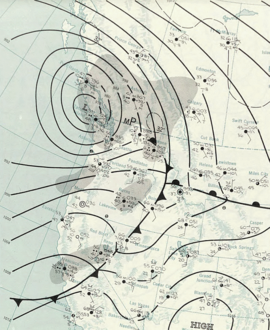Columbus Day Storm

Surface Analysis of the storm near its peak intensity
|
|
| Type | Extratropical cyclone |
|---|---|
| Formed | October 3, 1962 |
| Dissipated | October 17, 1962 |
| Lowest pressure | 960 hPa |
| Maximum snowfall or ice accretion | Unknown |
| Damage | $230 million (1962 dollars) |
| Casualties | 46 fatalities |
| Areas affected | Pacific Northwest and British Columbia |
The Columbus Day Storm of 1962 (also known as the Big Blow, and originally as Typhoon Freda) was a Pacific Northwest windstorm, that struck the West Coast of Canada and the Pacific Northwest coast of the United States on October 12, 1962. It is considered the benchmark of extratropical wind storms. The storm ranks among the most intense to strike the region since at least 1948, likely since the January 9, 1880 "Great Gale" and snowstorm. The storm is a contender for the title of most powerful extratropical cyclone recorded in the U.S. in the 20th century; with respect to wind velocity, it is unmatched by the March 1993 "Storm of the Century" and the "1991 Halloween Nor’easter" ("The Perfect Storm"). The system brought strong winds to the Pacific Northwest and southwest Canada, and was linked to 46 fatalities in the northwest and Northern California resulting from heavy rains and mudslides.
A tropical storm named Freda formed 500 miles (800 km) from Wake Island in the central Pacific Ocean. The system became an extratropical cyclone as it moved into colder waters and interacted with the jet stream. The low redeveloped intensely off Northern California due to favorable upper level conditions, producing record rainfalls in the San Francisco Bay Area that delayed some games in the 1962 World Series between the San Francisco Giants and the New York Yankees. The low moved northeastward, and then hooked straight north as it neared southwest Oregon. The storm then raced nearly northward at an average speed of 40 miles per hour (64 km/h), with the center just 50 miles (80 km) off the Pacific Coast. There was little central pressure change until the cyclone passed the latitude of Astoria, Oregon, at which time the low began to degrade. The center passed over Tatoosh Island, Washington, before landing on Vancouver Island, British Columbia, where it weakened rapidly. As the cyclone moved through Canada, another cyclone formed on its southern periphery, which merged with this cyclone by October 17.
...
Wikipedia
